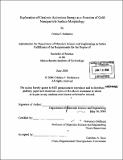| dc.contributor.advisor | Francesco Stellacci. | en_US |
| dc.contributor.author | Stefanescu, Cristina F | en_US |
| dc.contributor.other | Massachusetts Institute of Technology. Dept. of Materials Science and Engineering. | en_US |
| dc.date.accessioned | 2008-11-07T19:15:57Z | |
| dc.date.available | 2008-11-07T19:15:57Z | |
| dc.date.copyright | 2008 | en_US |
| dc.date.issued | 2008 | en_US |
| dc.identifier.uri | http://hdl.handle.net/1721.1/43207 | |
| dc.description | Thesis (S.B.)--Massachusetts Institute of Technology, Dept. of Materials Science and Engineering, 2008. | en_US |
| dc.description | Includes bibliographical references (p. 45). | en_US |
| dc.description.abstract | The application of rippled gold nanoparticles with bi-ligand surface morphology as a catalyst was tested. The hydrolysis of 2,4-dinitrophenyl acetate (DNPA) served as the catalytic reaction being analyzed and the bi-ligand composition used was 16-mercaptohexadecanoic acid to imidazole thiol (MHA to IT). The influence of temperature on catalytic reaction of DNPA with the MHA: IT system was tested for ligand rations of 2:1, 1:2, and 1:1 by monitoring the catalytic system on a UV-VIS spectrometer. Catalytic rate constants were obtained and found to increase with increased temperature. The measured catalytic rate constants were greatest overall for the 1:1 system, followed by the 1:2 system, and lastly the 2:1 system. The activation energy for each ligand-ratio system was measured and found to be 22.17 kJ/mol for the 2:1 system, 14.7 kJ/mol for the 1:2 system, and 26.52 for the 1:1 system. The 2:1 and 1:2 systems followed the trend of lower activation energy values for systems with faster rates; however the 1:1 system did not fit this trend as it resulted in the highest activation energy value as well as the fastest reaction rates. | en_US |
| dc.description.statementofresponsibility | by Cristina F. Stefanescu. | en_US |
| dc.format.extent | 45 p. | en_US |
| dc.language.iso | eng | en_US |
| dc.publisher | Massachusetts Institute of Technology | en_US |
| dc.rights | M.I.T. theses are protected by
copyright. They may be viewed from this source for any purpose, but
reproduction or distribution in any format is prohibited without written
permission. See provided URL for inquiries about permission. | en_US |
| dc.rights.uri | http://dspace.mit.edu/handle/1721.1/7582 | en_US |
| dc.subject | Materials Science and Engineering. | en_US |
| dc.title | Exploration of catalysis activation emergency as a function of gold nanoparticle surface morphology | en_US |
| dc.type | Thesis | en_US |
| dc.description.degree | S.B. | en_US |
| dc.contributor.department | Massachusetts Institute of Technology. Department of Materials Science and Engineering | |
| dc.identifier.oclc | 259121530 | en_US |
